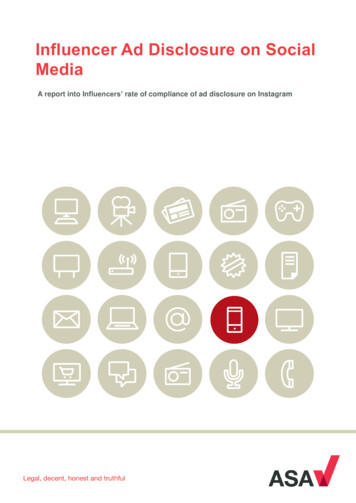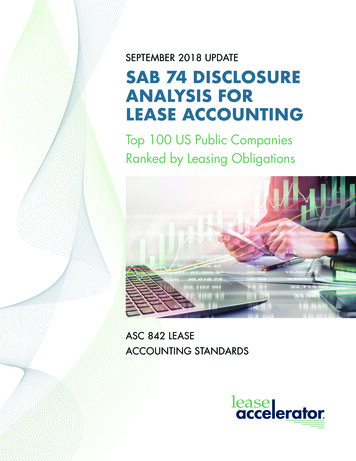
Transcription
Influencer Ad Disclosure on SocialMediaA report into Influencers’ rate of compliance of ad disclosure on Instagram
ContentsExecutive Summary. . .3Introduction .4The Code Rules . 5Monitoring .6Key Recommendations for Influencers and Brands .8Further Action .9
Executive summaryWith steadily rising complaints to the ASA about whether influencer ads are appropriatelydisclosed on social media, we proactively monitored a select group of influencers with whomwe have previously been in contact about how to disclose content as advertising. We did thisto establish their rate of compliance with rules which require ads to be obviously identifiableas such.The three week monitoring period focused on content on Instagram because complaints tothe ASA about Influencer ad disclosure tended to be on this particular platform. The rules onad disclosure apply to all platforms and media where influencers choose to engage inadvertising.Our analysis of over 24,000 individual ‘Stories’, posts, IGTV and reels across 122 UK-basedinfluencers revealed a disappointing overall rate of compliance with the rules on making itsufficiently clear when they were being paid to promote a product or service.We have therefore written to all of the Influencers we monitored and the main brands whohad partnered with one or more of them. Brands are held equally responsible for failing toadequately disclose advertising content.We have also requested that the influencers provide an assurance of future compliance withthe rules and will undertake monitoring to ensure that they comply – or face sanctions.What did we find? Inconsistent disclosure across Stories - when a piece of ad content spans anumber of consecutive Stories, unless it’s absolutely clear that this is part of the sameposting, each Story must be disclosed as an ad. Inconsistent disclosure across Stories, IGTV, Reels, posts – we noted instanceswhere a post would be accurately disclosed as an ad but a corresponding Story, wasnot. Visibility of ad labels – where Stories were labelled as ads, we noted labels wereoften in a small font, obscured by the platform architecture or otherwise difficult to spot;mainly due to being in a very similar colour to the background of the Story where itwas placed. Affiliate content is still an ad – we noted the use of #affiliate or #aff with no additionalupfront disclosure; those labels are not likely to be enough on their own to disclose tousers the advertising nature of the content. Own-brand ads – Influencers should not rely on bios or past posts to make it clearto consumers that they are connected to a product.Influencer Ad Disclosure on Social Media3
IntroductionBoth the CAP Code and the law require marketers to leave consumers in no doubt aboutwhen they are engaging with advertising, and this includes advertising on social media. Thisis not a new rule specific to social media, it is a rule that has been applied across all nonbroadcast media via the CAP Code and the equivalent rules in the BCAP Code for broadcastmedia, for many years.The emergence of new platforms online has enabled new methods of incorporating marketingcommunications within and around editorial or other non-advertising content. However, ourown Ad Labelling research and Ofcom research shows the difficulty that consumers have indistinguishing certain types of online ads from surrounding content. Clear and prominentdisclosure is therefore essential; in short, it must be obvious to consumers before they read,‘like’ or otherwise interact with content if it is a marketing communication.The ASA and CAP have invested significant resource and effort into helping the influencermarketing industry understand their responsibilities under the ad rules. On top of thenumerous rulings the ASA has published on ad disclosure on social media, we have hostedan ‘Influencer Responsibility’ event and produced numerous pieces of advice online,including the ‘Influencers guide to making clear that ads are ads’ and a ‘cheat sheet’,specifically designed to help Love Islanders navigate the rules.In spite of the work already undertaken to help influencers stick to the rules, complaints tothe ASA on this subject remain high: 2020 saw a 55% increase on 2019 in complaintsreceived about influencers, from 1,979 to 3,144 individual complaints. 61% of thosecomplaints in 2020 were about ad disclosure on Instagram.With influencer marketing continuing to grow as the popularity of social media apps increasesdue to consumers spending more time online, it is likely that the ASA will receive morecomplaints about this type of advertising. Our 2019 Annual Report demonstrated thatcomplaints about influencer posts made up more than one quarter of all complaints aboutonline media, with online media complaints making up just short of half of all the complaintsmade to the ASA in 2019.Influencer advertising is not new and whilstwe’re heartened to see large elements ofthe industry maturing and disclosing adcontent transparently, we continue to seefar too many incidences of non-disclosure,which threaten to bring this marketingdiscipline into disrepute and breed distrustin consumers. Through easy to use CAPguidance for influencers on how to complywith the rules, there issimply no excuse forinfluencers not to makeclear to consumers whencontent has been paidfor by a brand.Influencer Ad Disclosure on Social Media4
The Code RulesThe CAP Code applies in full to ads in all non-broadcast media, including digital platforms,such as Instagram, Facebook, YouTube, Snapchat, Twitter and TikTok. Many of these Coderules are underpinned by legislation, including the Consumer Protection from Unfair TradingRegulations 2008 (CPRs). If an influencer fails to sufficiently disclose that a post is in factmarketing, then not only are they breaking the CAP Code, they – and the brand they’reworking with – may well be breaking the law.The relevant ad disclosure rules of the Code state:We consider that, in most cases, the use of #ad (or similar) is the clearest way ofcommunicating the commercial nature of advertising content, though using a platform’s owndisclosure tools, such as Instagram’s Paid Partnership tool, can also help to distinguishadvertising from other content.Influencer Ad Disclosure on Social Media5
MonitoringIn September 2020, CAP undertook a three week monitoring exercise to review the Instagramaccounts of 122 UK-based influencers to assess whether advertising content was beingproperly disclosed. The focus was on Instagram Stories because complaints made to theASA were predominantly about this platform and this particular platform feature, but we didalso consider posts, reels and IGTV. We also understood that ad spend on Instagram Storieshas also been increasing significantly1.Monitored content was considered very likely to be advertising when it included a “push” toconsumers towards a brand. This might include explicit reference to a discount code or a“swipe up” message, for example. Or, where the content was otherwise clearly linked to aspecific product or service via traditional advertising references to price, benefits ofproduct/service (with no corresponding negatives), highlighting of a brand, etc. Years ofexperience regulating complaints about influencer content have helped us to identify whenthe content is very likely to amount to undisclosed advertising.Influencers were primarily chosen on the basis of having been previously contacted aboutnon-disclosure of advertising by the ASA, either in response to a complaint or via our selfinitiated, proactive engagements with them on the matter.As part of that work, we identified a significant number of Stories that were likely to be adsthat had not been disclosed as such.We assessed over 24,000 Stories and compliance rates were far below what we wouldexpect. We categorised nearly one in four Stories as marketing and considered that only 35%of them were clearly labelled and obviously identifiable as advertising.24,208 Stories were assessedNumber of Stories which were EditorialcontentNumber of Stories which were Ads18,476(76.3%)5,732(23.7%)Out of 5,732 AdsAds Insufficiently Labelled as AdsAds Clearly Labelled as pend/568854/#: :text g%20on%20Facebook%20Stories.Influencer Ad Disclosure on Social Media6
Ads by SectorBeautyClothing22%24%LeisureFood and Drink2%2%7%Fitness/Diet/Weightloss7%Home, Garden and Cleaning24%Jewellery and Accessories12%OtherAds were largely found to fall into three sectors: Beauty, Clothing and Leisure. This is perhapsunsurprising to those who interact with Instagram on a daily basis and see posts, in theirfeeds, promoting make-up, fast-fashion, luxury brands and various trips to hotels, spas, andtheme parks.However, in terms of following the rules, no sector stood out as having an acceptable rate ofcompliance when it came to labelling ads. This suggests that neither influencers nor thebrands are taking enough care to ensure consumers know when influencer marketing isoccurring.Percantage of Ads for each Sector which weresufficiently disclosed as AdvertisingOtherJewellery and AccessoriesHome, Garden and CleaningFitness/Diet/WeightlossFood and DrinkLeisureClothingBeauty0%10%Influencer Ad Disclosure on Social Media20%30%40%50%60%7
Key recommendations for Influencers and BrandsOur analysis noted some trends behind the low rates of compliance: Inconsistent disclosure across Stories - when a piece of ad content spans anumber of consecutive Stories, unless it’s absolutely clear that this is part of the sameposting, each Story must be disclosed as an ad. It’s not enough to label only the firstStory, for example, as it might not be seen and subsequent, unlabelled Stories maynot be obviously recognisable as ads Inconsistent disclosure across Stories, IGTV, Reels and posts – we notedinstances where a post would be accurately disclosed as an ad but a correspondingStory, was not. Moreover, if an influencer creates a Story to highlight a “new post” totheir feed, and the new post is an ad, the Story must make that clear. Visibility of ad labels – where Stories were labelled as ads, we noted labels wereoften in a small font, obscured by the platform architecture or otherwise difficult to spot;mainly due to being in a very similar colour to the background of the Story where itwas placed. The label must be present and be easy to spot, on desktop, mobile orother devices. In posts, we noted the #ad label frequently appeared at the end of ablock of text, sometimes below the fold; ad disclosure should essentially be the firstthing the consumer sees.- Here, the influencer has used both the platform’sown disclosure tool and #AD, but neither aresufficiently clear for consumers to see. Affiliate content is still an ad – we noted the use of #affiliate or #aff with no additionalupfront disclosure; those labels are not enough on their own to disclose to users theadvertising nature of the content.2. Influencers should label affiliate marketing in thesame way as other advertising content; we recommend using #ad. This includes whenan influencer promotes a discount code. Own-brand ads – Influencers should not rely on bios or past posts to make it clear toconsumers that they are connected to a product. If they state clearly in their Story:“Here is my book”, “Download my app”, “Today we have launched my collection”, it islikely to be clear that they are connected to their product, which they are marketing.But, where their content does not make it clear, then the ad must be labelled in asufficiently prominent fluencer Ad Disclosure on Social Media8
Further ActionWe have written to all the influencers we monitored, as well as a number of brands whofeatured in undisclosed ads. We have shared the compliance themes, referenced in thisreport, with them and put them on notice that we will conduct future monitoring spot checks.If those spot checks reveal further incidences of non-compliance, we will take enforcementaction. Our sanctions include a dedicated non-compliant page on our website and targetedpaid search ads on platforms.The Competition and Markets Authority (CMA) has been conducting its own work in this area.Facebook (owner of Instagram) provided the CMA with undertakings in October 2020 that itwill do more to prevent “hidden advertising” being posted on its Instagram platform. Weexpect the combined efforts of all organisations to improve compliance within the influencerlandscape.Advertising Standards AuthorityCastle House37-45 Paul StreetLondon EC2A 4LSTelephone: 020 7492 2222Textphone: 020 7242 8159www.asa.org.ukFollow us: @ASA UKInfluencer Ad Disclosure on Social Media9
Influencer Ad Disclosure on Social Media 3 Executive summary With steadily rising complaints to the ASA about whether influencer ads are appropriately disclosed on social media, we proactively monitored a select group of influencers with whom we have previously been in contact










